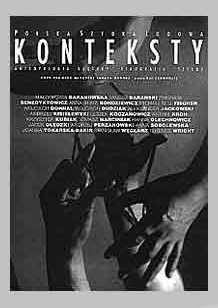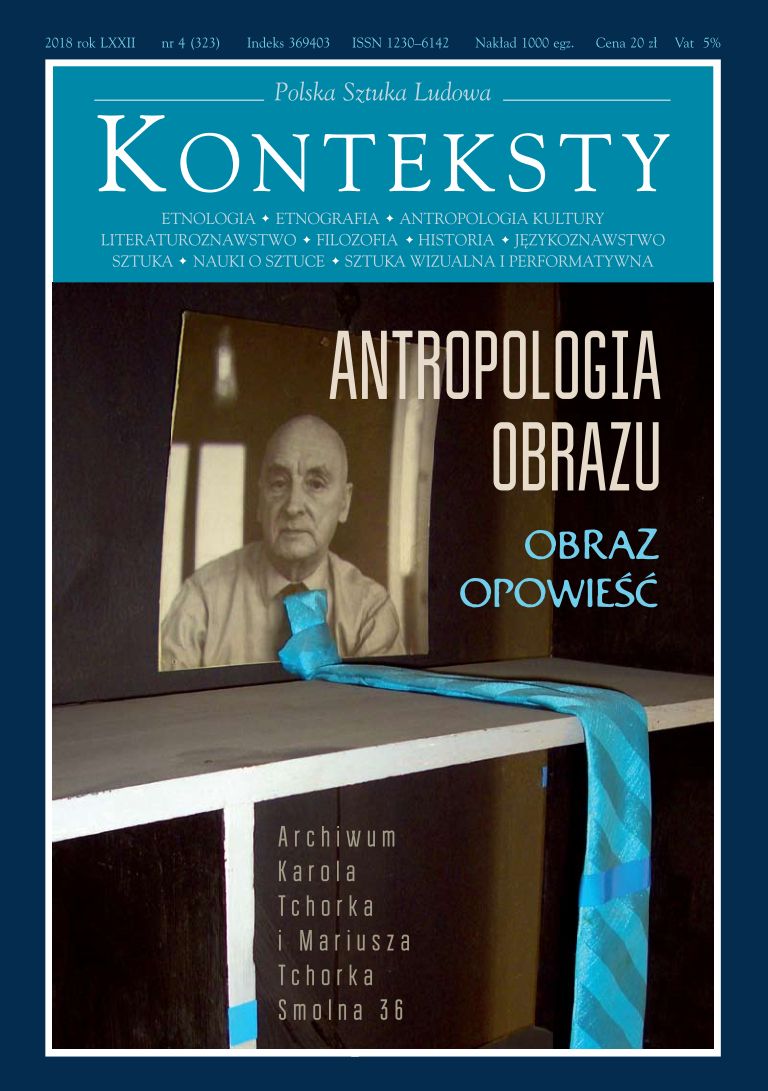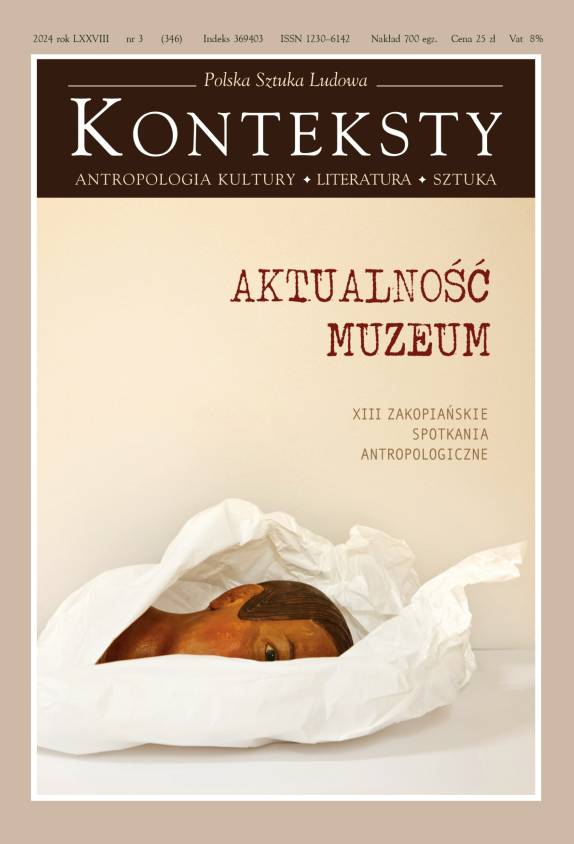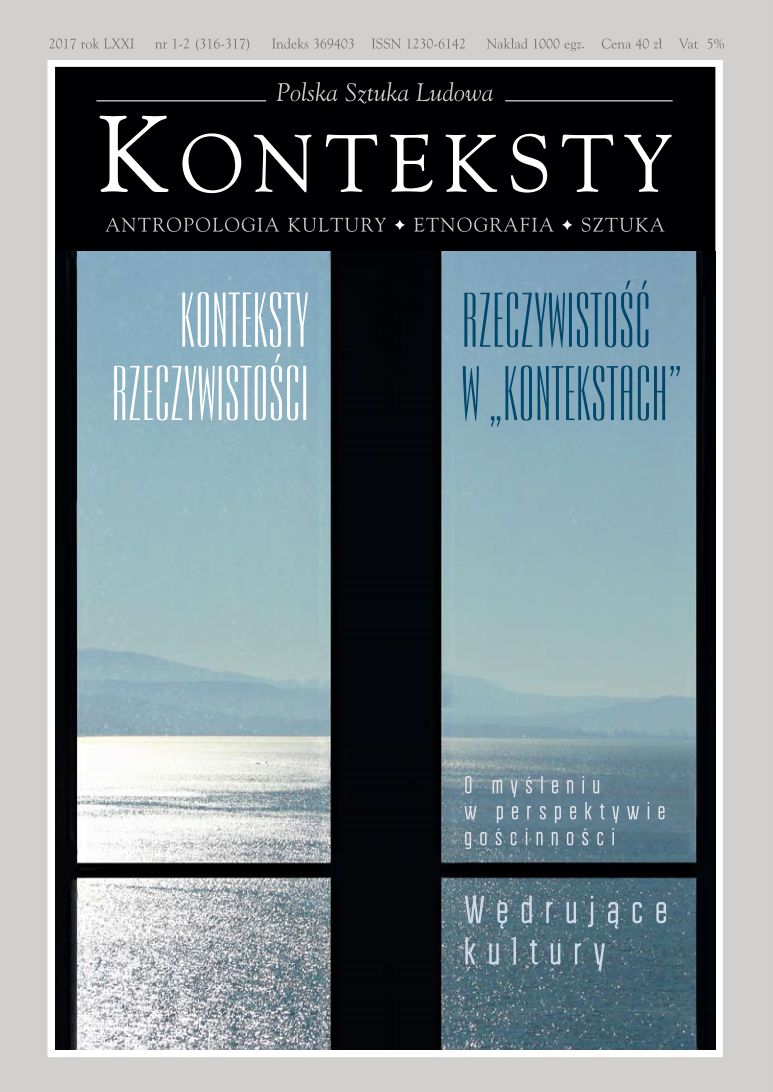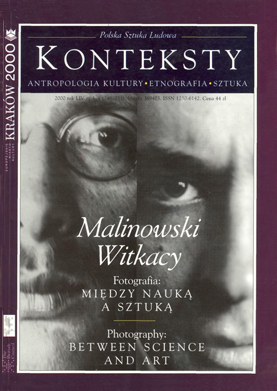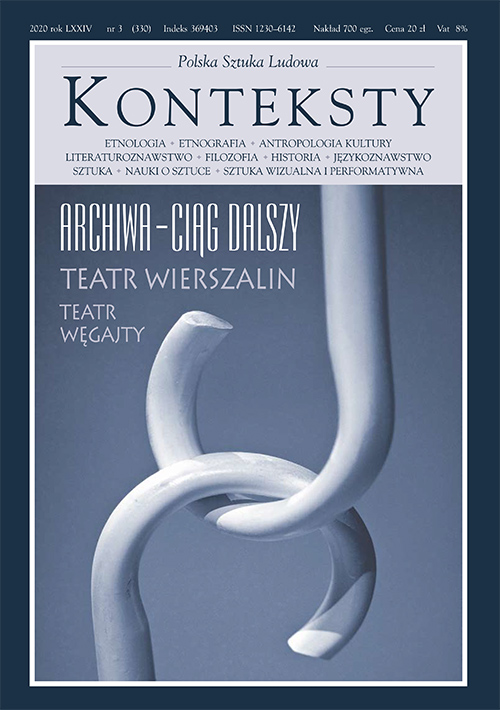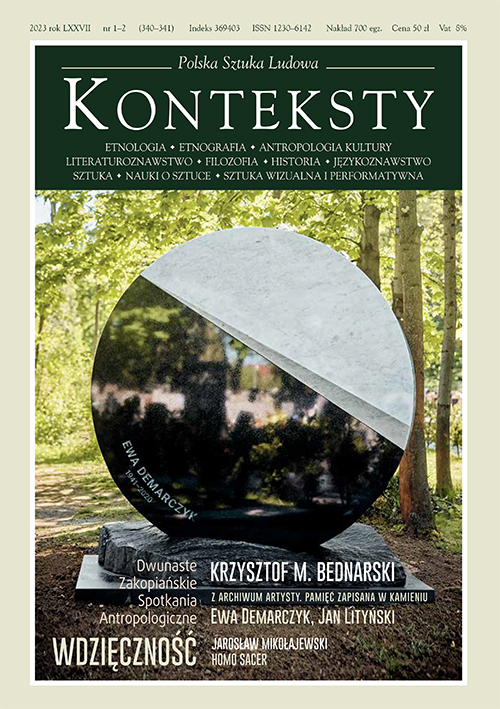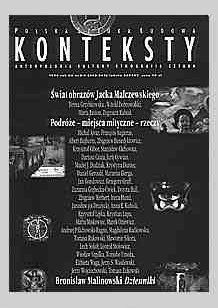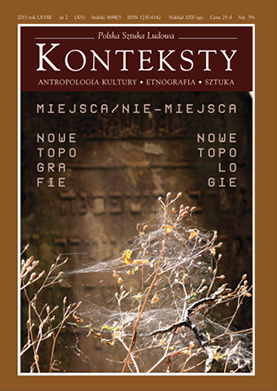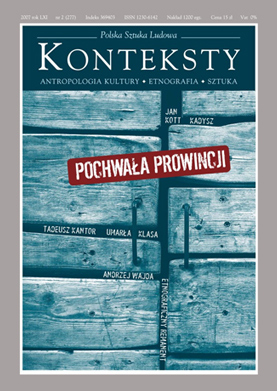Issue 2013/3 (302) - Konteksty

| W. J. T. Mitchell | Iconoclasm in the Age of “Biocybernetical Reproduction” | |
| Łukasz Zaremba | Iconoclasts and Iconophiles  | |
This text delves into the problem of avoiding iconoclasm envisaged as critical praxis – the removal of supposedly mendacious images and intercessions. Pondering the quest for the possibility of conducting non-iconoclastic critique postulated by Bruno Latour it refers to the world of images and literally conceived iconoclasm. Upon the example of the assault carried out by Daniel Olbrychski against images from The Nazis series by Piotr Uklański (2000, Zachęta, Warsaw) the author considered artistic responses to the attack, showing the way in which Uklański pursued the activity of an iconophile - interested not in a single image (idolatry) or the abolition of images (iconoclasm) but their motion, multiplication, and transition between the media and forms. | ||
| Jaś Elsner | Iconoclasm as Discourse: from Antiquity to Byzantium  | |
Iconoclasm from archaic Greek antiquity into Byzantium was an attack on the real presence of the depicted prototype through an assault on its material image. But during the moment of Byzantine Iconoclasm in the eighth and ninth centuries, for the first time, thinks on both sides of the debate – Iconophiles and Iconoclasts – considered the image entirely as representation. This is a transformative moment in the discourse of images in the entire Western tradition. For it liberated the image from an emphasis on ontology to place it in an epistemological relation to its referent. The impulse in Byzantium to re-evaluate the meanings of images emerged from debates within ancient pre-Christian culture, between Christians and pagans, and between Christians, Jews, and Muslims. It was a profound influence on the understandings of images in the later Middle Ages and the Reformation. | ||
| Tomasz Swoboda | Offending the Image  | |
The article proposes to reflect on the ostensibly cratylusian question of offending an image by discussing its two aspects. The first is literal offence, i.e. physical violation of existing images conceived as part of the creation of new ones, as exemplified by some of the works of Arnulf Rainer and Nobuyoshi Araki. The second aspect involves offending the image of man, performed with the assistance of photographic and painted portraits of plants and insects undermining the anthropocentric model of perceiving the world. | ||
| Roma Sendyka | Spolia about Images on/in Images  | |
A presentation of discussions accompanying compositions by the Chapman Brothers “supplementing” valuable and unique works of art. The activity of the Chapman Brothers is often accused of “vandalism”, “profanation” or “maiming” works of art. The artists opted for the term: rectifying. Roma Sendyka discussed the “maiming” or correcting of artworks as a serious creative and interpretation-oriented tactic, one of the important artistic gestures of twentieth-century art. Upon the example of a transformed series of works by Goya or the composition by Edward Dwurnik from 2009, created by combining an original Dwurnik composition with a painting by another artist, Bartek Materka, the article, using the category of spoliation, discusses complicated inter-discursive strategies of creating inter-image relations. | ||
| Joseph Koerner | The Icon as Iconoclash  | |
A translation into the Polish of an article originally published in the book: Iconoclash (Karlsruhe 2002), with a new introduction by the author. The topic involves the “image wars” waged during the Reformation. Koerner showed their conceptual complexity, the co-dependence of both attitudes – iconoclastic and iconophilic, the dialectical relation of violence against images and the violence of images: image breaking always shadows image making; religious images are engines of the iconoclash (a term introduced by Bruno Latour: a moment of transition between having images and having done with images) that periodically destroys and renews them. | ||
| Wojciech Michera | “On This Side of the Eyelashes”. Non-place, Non-person, Photo-graphy  | |
The fundamental part of this essay is an analysis of a fragment from the autobiography of Roland Barthes, i.e. a photograph showing a theatrical spectacle in which Barthes took part in the courtyard of the Sorbonne, and a commentary connected with the photograph in question. By referring to other texts, both by Barthes and, i.a. Lacan, Foucault, Benveniste and Derrida, author demonstrated that within this visual-literary discourse the masked figure of the “author-actor” is not solely an “arbitrary and external sign of identity” (as is sometimes believed) but a non-person (non-personne), “non-place” (non-lieu), and a figure radically questioning the subjectivity of the narrator. A careful (narratological) analysis of this scene shows that the “mask” is negated, and ceases to be a “symbol”, thus assuming the subversive features that Barthes linked with the concept of “photography”. | ||
| Szymon Wróbel | Roland Barthes Reads The Map and the Territory by Michel Houellebecq  | |
In his most personal book: La chambre claire. Note sur la photographie Roland Barthes proposed a hypothesis claiming than the genius of photography is concealed in special, one-time, and absolutely idiomatic existence, in a language expressible only with the help of the word: contingence, which means both contiguity and randomness. The evocation of Barthes and meditation on La chambre Claire are supposed to create a mood for a more inquisitive and sensitive approach to the latest book by Michel Houellebecq: The Map and the Territory. The author was concerned not only with the fact that all the tropes concerning photography and set into motion by Barthes and partly by Benjamin return in Houellebecq’s book. He is also not interested that Barthes or Benjamin provide methodological devises that make it possible to conduct a more scrupulous “interpretation” of The Map and the Territory. Actually, a confrontation of the confessions made by Barthes and the novel by Houellebecq allows to rethink the category of evidence and the process of providing evidence by the art of photography. It permits to ask the question: what is registration? What is evidence? And what is the function fulfilled today by registration and photographic modelling in “evidence” about the outer surface (if not the nature) of the world, and in particular the world of objects deprived of speech? | ||
| Hito Steyerl | In Defence of the Poor Image  | |
When we demand HD quality projection on a cinematic screen, with perfect image and sound, we succumb to a certain, by no means indifferent and obvious ideological vision of the image. Hito Steyerl proved that by focusing on quality and fetishising quality capitalism has led to the exclusion of a considerable part of image creativity that no longer matches the present-day economic structure of full-screen cinemas, DVD HD, etc. The author drew attention to the fact that low quality digital images - transmitted by net users – offer a chance for an independent renascence of the auteur cinema, the cinematic essay, etc. If we abandon our attachment to quality, we shall restore into circulation – thanks to enthusiasts who today possess suitable measures for illegally copying the classics of the film avangadre – a considerable part of the independent progressive and valuable image-printed oeuvre, which does not fit today’s capitalist vision of the circulation of images. The author thus protests against the fetishisation of the power of images and urges to turn towards poor images. | ||
| Magda Szcześniak | Iconoclastic Looks  | |
On February 16 2011 the Warsaw supplement to “Gazeta Wyborcza” contained a text by Agnieszka Kowalska describing the unrealized mural by Karol Radziszewski. The composition was to have been located in the Warsaw Uprising Museum and its execution was entrusted to the young artist in 2009. Radziszewski prepared a project showing the insurgents performing ordinary, everyday activities of the battlefield: “doing the laundry, resting, sunbathing”. According to the journalist, the Museum director described the mural as “too erotic” and decided to reject the project claiming that its realisation could have hurt the feelings of living insurgents. The conflict and ensuing discussion concerning the unrealised project and its other embodiments became a point of departure for the article’s reflections on the identity polities and visibility in public space. | ||
| Katarzyna Bojarska | Art That Hurts? The Limits of the Critical Gesture and Painful Memory and Censorship  | |
The article deals with the shift in visual art production and criticism from the acts of commemorating the historical event to the acts of criticism aimed at the social and symbolic production of meanings, emotions, memories. The author analyses the crisis caused by such artistic undertakings (Libera, Żmijewski, Sierra, among others) and the acts of censorship related to them. She is mostly interested in ways the discourse of emotions and affects is employed in these acts of contemporary iconoclasm and could be productively overtaken by artistic and critical discourse which would, at the same time, fulfil its political and ethical obligations. | ||
| Mateusz Salwa | Outrage. How to Respond to Offensive Images?  | |
The article defines iconoclasm as all sorts of protest against images, and at the same time draws attention to the joint etymological roots of the word obraz (image) and obraza (offence). Next, by referring to Bruno Latour’s conception of iconoclash – and considering the attack launched against Maurizio Catellan’s The Ninth Hour - it shows the proximity of iconoclasm and iconophilia. The key question posed in the text concerns the possible reaction to the iconoclastic gesture of the artistic image, which at the same time wishes to possess the power of social impact and to retain inviolability resulting from its status of high art. | ||
| Kamil Kopania | Intimate Relations with Little Iza. The Attack against the Arsenal Gallery in Białystok in 2001-2005  | |
A discussion of the story and context of attacks conducted by representatives of rightist parties against the Arsenal Gallery in Białystok. Attempts at censoring the exposition on display at the Gallery took place on 2001-2005 and assumed various forms and intensity. Artists showing their works were accused of creating pseudo-art, insulting religious feelings, and even promoting paedophilia. The article presents the methods applied by representatives of right-wing parties intent on disavowing the Gallery and demonstrated the absurdity of the charges formulated against it. Kamil Kopania also outlined the media and social reception of the controversies. | ||
| Gridley Mckim-Smith | The Rhetoric of Rape, the Language of Vandalism  | |
A presentation of structural similarity between the rhetoric of rape and the rhetoric applied by the press and museums while attacking a work of art on show. The domination of the image becomes apparent in this situation both in the readiness to conceal a scandal and ascribing to the image the label of a provocateur, i.e. the one who is guilty. Having reconstructed the fundamental rhetorical scheme, in which the assailant appears in the role of male rapist and the image corresponds to the raped woman, McKim-Smith indicated instances of unambiguity and “transgender quality” when the attacker is a woman: take the example of the famous suffragette Mary Richardson, who at the beginning of the twentieth century damaged The Rokeby Venus by Velazquez. | ||
| Paulina Kwiatkowska | Lucky to Be Alive, or How to Survive in the World/in an Image  | |
The author ruminated about the relation between the film image and reality, film “subjectivism” and “objectivism”, and selected as her point of departure an attempt at a theoretical view of montage as the basic practice applied by censorship. In exceptional cases, censorship, whose task is usually the elimination of all that appears to be menacing or disturbing in the film matter, proves to be a practice consisting of an implantation into the film image of elements used for taming it and rendering it unambiguous. Those alien elements, inserted into the film via montage, function in the manner of a fig leaf, which, however, cannot be interpreted exclusively in the categories of authority and its pacifying or moralising activity within the domain of art. In his last film: Eyes Wide Shut, Stanley Kubrick, permitting, or perhaps outright provoking the inevitable intervention of censorship into the key orgy scene, revealed the very essence of our fear of images, which in the cinema often turn into fear of the camera and the power that it wins over the perception of the protagonist and the spectator. | ||
| Agata Zborowska | Clothes that awakened images of horror  | |
On 27 January 1995 at the Paris Fashion Week the Comme des Garçons fashion house presented collection entitled Sleep. Among the clothes there were sets consisting of blue-and-white, vertically striped trousers and shirts. The direct reference was supposed to be clothing resembling classic men’s pyjamas. The show provoked great interest in the media, which presented unanimously negative interpretations of the show. They noticed that on the same day, exactly 50 years before the show, the soldiers opened the gates of the Auschwitz concentration camp. Comme des Garçons in popular opinion had made a conscious reference to the uniforms of the concentration camp’s prisoners. The author analysed the origins and consequences of the censorship that resulted in the collection not only physically disappearing, but also almost all of its traces have been eliminated. | ||
| Agnieszka Pajączkowska | Good, bad, and “new” photographs of Shoah  | |
The article provides a case study – an analysis of so called “diggers photography” used as a starting point and main basis for a book Golden Harvest: Events at the Periphery of the Holocaust by Jan T. Gross and Irena Grudzińska-Gross. Unveiling the methods of constructing the picture meaning that is expressed in the book, the author attempts to deconstruct a strategy of using photography medium as transparent “truth” and natural “evidence”. The consideration of photographical medium as problematic and dialectic, involves an analysis of unknown picture from Yad Vaschem Archive, well-known Self Portrait as a Drowned Man by Hippolyte Bayard and thought of Georges Didi-Huberman from his books Images in Spite of All and Quand les images prennent position, L’oeil de l’histoire: Tome 1. | ||
| Agata Sierbińska | The CIA Can Only Watch  | |
On 2 May 2011 Barack Obama informed about an action conducted by the elitist Navy SEALs, which ended in the death of Osama bin Laden. The White House illustrated this piece of information with a photograph showing American officials looking at a screen, probably beyond the take and showing the course of events. The photograph inspired numerous commentaries: why did the American authorities not publish the most anticipated image, that of the corpse of Osama bin Laden, what was the significance of the gestures performed by the persons gathered at the White House command centre; it also became extremely popular material for authors of Internet memes. In the presented text the history of the photograph becomes a visor showing the unclear status of portrayals of Osama bin Laden and Barack Obama; likenesses possess a separate identity (or life) and effectively resist those who trie to kill them or use them for private purposes. | ||
| Anna Mikołejko | Peintres de l’âme  | |
Marian Grużewski (next to Adam Dobrzański, Nina Filipowska, Arnold Radwan Radziszewski and many others) is regarded as a trance, medium painter. True, he studied painting but was always affected by the fact that he first became known as a medium, in contrast to Kazimierz Stabrowski, who was first recognised as an artist and subsequently revealed his supernatural talents. Both, however, found themselves in a trap of ambivalent assessments caused by mediums prior to the Second World War. The situation was additionally complicated by the fact that such artists were, as a rule, also interested in spirituality, theosophy, anthropology, and other currents regarded as part of the occult current and were actively opposed by the Church. In this fashion, despite the fact that the oeuvre of both painters was regarded as “firmly embedded in Christian doctrine”, they were considered suspicious. Gruzewski hoped to capture the invisible in the visible world, and thus to discover truth inaccessible for the senses. Moreover, he tried to create “arythmosophy”, a mathematical science proving the correctness of the premises of the occult. In turn, Stabrowski strove towards depicting inner reality, accessible only for the soul, experienced by the latter and heard and seen with its sight, hearing, and, predominantly, emotion. He regarded it to be just as real as outer, material reality. These attempts cast a shadow on the careers of both men: Stabrowski was forced to resign as director of the School of Fine Arts, which he founded, and Grużewski was compelled to face a campaign of slander and libel. Their art, once the object of interest, now became criticised. The categories of good and evil were actually located beyond it - in stereotypes governing the intellect- and images played merely the role of a sensitive barometer of a cruel social game. | ||
| Jacek Świdziński | Timing: the Drive of Comic Book Images  | |
The author proposed becoming acquainted with two interpretations of Three Paradoxes, a comic book by Paul Hornschemeier. According to the first approach to the text, intent on discovering the meanings of elements of the story, the construction of comic book narration makes it impossible to ascribe uniform interpretations to sequences of images. The second approach thus proves to indispensable, being focused on an analysis of mechanisms that, creating an obstacle for the former one, deprive the reader of instruments connecting the meanings of the comic text. By circulating around the problem of the depiction of time in the static space of images the author of the article carried out a (re)interpretation of the properties of the comic book story (sequentiality, fragmentariness, timing taken from the classical theory of Will Eisner) as well as certain features of visual narration as a whole. | ||
| Vivian C. Sobchack | No Lies: the Direct Cinema as Rape  | |
An analysis of the short-feature film: No Lies (M. Bloch, 1972) telling about the rape of a young woman while applying the cinéma vérité convention. Having conducted a survey of assorted film techniques of showing rape, the author proved the existence of parallels between the contents of a story told by the director and the way of conducting film narration. Comparing the document, full of manipulation, to raping the spectator V.C. Sobchak questioned supposed passivity branded with voyeurism and connected with the experience of watching a documentary film. | ||
| Marcin Napiórkowski | The Odyssey of Guernica. The Image, Power, Death, and Historical Memory  | |
The article deals with the cultural biography of Guernica by Pablo Picasso, locating it within the context of the anthropology of memory. Twentieth-century transformations of culture, within whose range the cult of the victors has been supplanted by the cult of the victims, became the reason why depictions of death – once an important instrument of the legitimisation of all authority – now comprise the key tool of delegitimisation. In the text this thesis is exemplified by the successive stages of the wanderings of Guernica: from the time of its origin, “exile” in Europe and the USA, and “meaningful absence” in Francoist Spain to controversies connected with a return to its native land. At the time, Picasso’s painting served as a tool of iconoclasm (a weapon in the “war of images”) while becoming the object of numerous attacks. | ||
| Boris Uspienski | Time in The Nose by Gogol The Nose by Ethnographer | |




